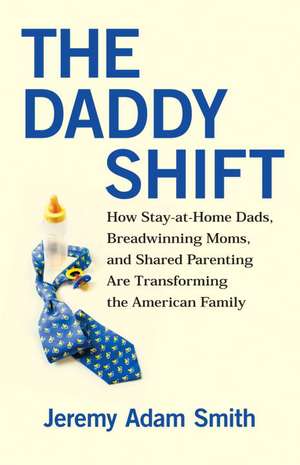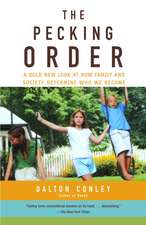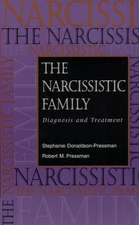The Daddy Shift: How Stay-At-Home Dads, Breadwinning Moms, and Shared Parenting Are Transforming the American Family
Autor Jeremy Adam Smithen Limba Engleză Paperback – 31 mai 2010
It's a growing phenomenon among American families: fathers who cut back on paid work to focus on raising children. But what happens when dads stay home? What do stay-at-home fathers struggle with-and what do they rejoice in? How does taking up the mother's traditional role affect a father's relationship with his partner, children, and extended family? And what does stay-at-home fatherhood mean for the larger society?
In chapters that alternate between large-scale analysis and intimate portraits of men and their families, journalist Jeremy Adam Smith traces the complications, myths, psychology, sociology, and history of a new set of social relationships with far-reaching implications. As the American economy faces its greatest crisis since the Great Depression, Smith reveals that many mothers today have the ability to support families and fathers are no longer narrowly defined by their ability to make money-they have the capacity to be caregivers as well.
The result, Smith argues, is a startling evolutionary advance in the American family, one that will help families better survive the twenty-first century. As Smith explains, stay-at-home dads represent a logical culmination of fifty years of family change, from a time when the idea of men caring for children was literally inconceivable, to a new era when at-home dads are a small but growing part of the landscape. Their numbers and cultural importance will continue to rise-and Smith argues that they must rise, as the unstable, global, creative, technological economy makes flexible gender roles both more possible and more desirable.
But the stories of real people form the heart of this book: couples from every part of the country and every walk of life. They range from working class to affluent, and they are black, white, Asian, and Latino. We meet Chien, who came to Kansas City as a refugee from the Vietnam War and today takes care of a growing family; Kent, a midwestern dad who nursed his son through life-threatening disabilities (and Kent's wife, Misun, who has never doubted for a moment that breadwinning is the best thing she can do for her family); Ta-Nehisi, a writer in Harlem who sees involved fatherhood as "the ultimate service to black people"; Michael, a gay stay-at-home dad in Oakland who enjoys a profoundly loving and egalitarian partnership with his husband; and many others. Through their stories, we discover that as America has evolved and diversified, so has fatherhood.
Preț: 114.01 lei
Nou
Puncte Express: 171
Preț estimativ în valută:
21.82€ • 23.71$ • 18.34£
21.82€ • 23.71$ • 18.34£
Carte disponibilă
Livrare economică 31 martie-14 aprilie
Livrare express 15-21 martie pentru 25.11 lei
Preluare comenzi: 021 569.72.76
Specificații
ISBN-13: 9780807021217
ISBN-10: 0807021210
Pagini: 232
Dimensiuni: 147 x 220 x 19 mm
Greutate: 0.37 kg
Editura: Beacon Press (MA)
ISBN-10: 0807021210
Pagini: 232
Dimensiuni: 147 x 220 x 19 mm
Greutate: 0.37 kg
Editura: Beacon Press (MA)
Recenzii
Jeremy Adam Smith is a most purposeful father, a periodic Stay-at-Home Dad who sees his role as not just a choice that's best for his family but as a sign of a rapidly changing societal landscape. . . . His new book, The Daddy Shift, is a chronicle of a time that he predicts we will look back upon as the start of permanent change.—Lisa Belkin, New York Times
"A combination of scholarly research (citing economic and historical trends, sociological and psychological studies, and labor statistics), revealing profiles of stay-at-home dads and their families, and poignant anecdotes from Smith's own life. The personal passages are the book's most affecting ones, as Smith reveals himself not as some know-it-all superdad but as a learn-as-you-go parent who had to sort out his own complex feelings."—Regan McMahon, San Francisco Chronicle
"His investigations are very well researched, and he's pursued them with a rigorous intellectual integrity that makes his arguments engagingly persuasive. The result is an impressive book that even the childless should read, for at essence, The Daddy Shift is not just about stay-at-home dads, but about the changing roles of men and women in society."—Mothering
"A gentle but persistent appeal to get beyond all those preconceived notions and make the choices that work best for ourselves and our families."—Body + Soul
"Forty years ago, a man who wanted to share child care equally with his wife would have been called 'deviant,' and a wife who wanted him to would have been condemned as an 'unnatural' mother. The Daddy Shift shows how far we have come and how much we have to gain by completing this revolution in marriage and parenthood."—Stephanie Coontz, author of Marriage, a History: How Love Conquered Marriage
"A combination of scholarly research (citing economic and historical trends, sociological and psychological studies, and labor statistics), revealing profiles of stay-at-home dads and their families, and poignant anecdotes from Smith's own life. The personal passages are the book's most affecting ones, as Smith reveals himself not as some know-it-all superdad but as a learn-as-you-go parent who had to sort out his own complex feelings."—Regan McMahon, San Francisco Chronicle
"His investigations are very well researched, and he's pursued them with a rigorous intellectual integrity that makes his arguments engagingly persuasive. The result is an impressive book that even the childless should read, for at essence, The Daddy Shift is not just about stay-at-home dads, but about the changing roles of men and women in society."—Mothering
"A gentle but persistent appeal to get beyond all those preconceived notions and make the choices that work best for ourselves and our families."—Body + Soul
"Forty years ago, a man who wanted to share child care equally with his wife would have been called 'deviant,' and a wife who wanted him to would have been condemned as an 'unnatural' mother. The Daddy Shift shows how far we have come and how much we have to gain by completing this revolution in marriage and parenthood."—Stephanie Coontz, author of Marriage, a History: How Love Conquered Marriage
Notă biografică
Jeremy Adam Smith’s writing has appeared in Mothering, the Nation, San Francisco Chronicle, Utne Reader, Wired, and elsewhere. A magazine editor, blogger, and former stay-at-home dad, Smith lives in San Francisco with his wife and son.
Extras
Twenty-First Century Dad
In 2004 my son Liko was born. Everything—the tree outside the
window, the dreams I had at night—changed.
For the first year of his life, my wife Olli stayed home with
Liko. Then she went back to work and I quit my job, joining the
ranks of caregiving dads.
Now it was just the two of us boys, and it was scary. Liko, a
confirmed breast addict, could not nap without his mother. When
I would lay him down, he’d wail inconsolably, relentlessly, reaching
out to me. But when I picked him up, he’d kick and arch his
back, his little hands pushing against my chest. This would go on
for hours.
I’d put him in the stroller and walk. He’d cry and fall asleep,
but if I stopped—in a bookstore, a coffee shop—he’d wake and cry
again, so I soon learned to keep moving through our San Francisco
neighborhood, sticking to the side streets, going up the hills
and down, up and down.
Time slowed, and with every minute I’d feel more and more
isolated, more and more anxious. I wondered: “Is my life now no
more than this?” I’d see people laughing in a picture window and
want to be one of them.
In time, I learned to let that go, let myself get lost. On foggy
days the hills of the city floated around us like deserted islands, the
stroller a lonely raft. I’d study the cornices and gables on the Victorian
facades, watch the tsunami of fog spill over Twin Peaks.
Later, Liko learned to fall asleep in my arms. I’d carry him
through all the rooms in our apartment, stepping carefully around
the bouncy seat, the swing, the baby gym, the high chair, the toy
basket. I’d do this for hours.
Then one momentous day, I sat down in a rocking chair and he
stayed asleep. I took a book down from the bookshelf. It was the
best book I’d ever read; I don’t remember its name. One afternoon
as the room darkened, his eyes snapped open and they met mine.
He smiled and said, “Dada,” and his small fingers curled around
my forefinger.
He was glad to see me there with him. And I was glad to be
there.
New Model Family
It is strange to think that such an intensely private moment might
be the product of a tectonic shift in society and the economy.
Although I felt acutely isolated when I was learning to take care
of my son, in fact I was not alone. Since 1965 the number of hours
that men spend on child care has tripled. Since 1995 it has nearly
doubled.1
In 2007 the Census Bureau counted 159,000 stay-at-home dads
in the United States, up from 64,000 in 1995.2 But these numbers
tell only part of the story of male caregiving, because they exclude
stay-at-home fathers who also do paying work. When we add fathers
who work part-time or from home, and who are primarily
or equally responsible for taking care of kids, the number of male
caregivers increases. According to a 2008 census report, for example,
one in four preschool children spend more time in Dad’s care
than any other arrangement while the mother is working,3 though
most of the fathers work at least part-time and probably do not call
themselves “stay-at-home dads.”
Many studies find that twenty-first-century couples divide paid
work, household labor, and child care far more equitably than couples
in the past.4 Some professional dual-income couples have even
achieved rough equality in their domestic divisions of labor,5 and
one-third of working-class couples work different, complementary
shifts and share care of young children.6 A great deal of evidence
also indicates that more fathers would adopt caregiving roles
if they felt it was financially feasible to do so: For example, a 2007
survey by Monster.com found that 68 percent of American men
would consider staying home full-time with their kids.
The bottom line is clear: during the past decade, the number
of caregiving fathers has risen dramatically. Dads now spend more
time with their children than at any time since researchers started
collecting longitudinally comparable data.7 This does not mean
that Americans have achieved an egalitarian utopia. The census
counts 5.6 million stay-at-home moms, compared to 159,000
dads.8 The University of Wisconsin’s National Survey of Families
and Households says that the average mother is doing five times as
much child care as the average father. When both parents work for
pay, Mom still beats Dad by a four to one ratio.9 If men as a group
have indeed increased their contributions at home—and they have
—they still don’t come close to matching what mothers do.
However, averages can be deceptive. They reveal the big picture
but, by doing so, obscure the many smaller pieces and countertrends
that give it shape. In truth, we are in a period of transition
when inequality coexists with progress. Some groups of men have
adopted flexible gender roles and embraced cooking, cleaning, and
taking care of kids, while other groups have not. The negative
examples, often glorified, are everywhere, while the positive ones
are often hidden and hard to find, especially for boys and young
men.
It is time for twenty-first-century dads to go on the offensive.
In this book I tell the stories of fathers who have embraced caregiving
and egalitarian marriages, explore the hopes and ideals that
inform their choices, and analyze economic and social developments
that have made their choices possible.
As we will discover, stay-at-home dads represent a logical next
step of fifty years of family change, from a time when the idea of
men caring for children was inconceivable, to a new era when atxii
home dads are a small but growing part of the landscape. This is
the “daddy shift” of the title: the gradual movement away from a
definition of fatherhood as pure breadwinning to one that encompasses
capacities for both breadwinning and caregiving.
Stay-at-home dads are the leading edge of the daddy shift, pioneers
who are quietly mapping new territory for all fathers. I focus
on stay-at-home dads for the same reason anthropologists study
lost tribes and obscure subcultures: to reveal the variety and potential
of human experience—and thus to suggest new possibilities
for organizing our lives.
But in many ways, this book is really about male caregiving
writ large. Stay-at-home dads represent one extreme of a continuum
that includes the growing number of dads who split work and
child care equally with their spouses, widowed or divorced custodial
dads (a group that has quadrupled in size since 1970), two-dad
families, and working fathers who have restructured their jobs in
order to make more time for their children. Many of the facts,
ideas, and trends I describe apply to all dads who have chosen to
prioritize, for one reason or another, care over paid work.
This is also a book about female breadwinning, which is, of
course, the main economic factor that makes stay-at-home fatherhood
possible. Prior to the 1960s, as we will discuss in chapter 1,
it was uncommon for mothers to work and nearly unheard of for
them to make more money than their husbands. Today, 80 percent
of mothers have jobs and one-third of wives make more money
than their husbands10—and we have every reason to believe that
these trends will intensify: today in America, for example, young
women outnumber men on college campuses, and they outearn
young men in many American cities.
As women’s incomes continue to rise—and they will—men
will be called upon to do even more housework and child care.
According to a growing number of studies, there is a direct relationship
between the amount of money women earn and the
amount of housework and child care men do. In 2006, for example,
Pennsylvania State University sociologist Jennifer L. Hook analyzed
forty-four time-use studies from twenty countries, and she
discovered that men’s housework and child care increases with national
levels of women’s employment, as well as the availability of
paternity leave.
Hook also found that widely available day care and preschool
correlates with higher levels of father involvement.13 At first glance
there might seem to be a conflict here: Wouldn’t more easily
available child care limit men’s participation in raising their kids?
Wouldn’t one trend counteract the other?
In point of fact, day care and father care are not antagonistic
categories. Though the pie representing total time with children
might shrink for dual-income couples using paid child care, moms
and dads must still find a way to slice up the hours and responsibilities
that remain. And, as we will explore in chapter 3, in relatively
egalitarian countries with subsidized, widespread day care
and early childhood education, the pressure is strong for fathers
to match mothers’ involvement. Most of the stay-at-home fathers
I interviewed for this book—like many stay-at-home moms—pay
for some amount of child care in order to do housework, work
part-time for pay, search for jobs, take classes, or carve out time for
themselves. Pitting paid care against stay-at-home parenthood sets
up a false dichotomy. Child care isn’t just for working mothers; it’s
for all parents.
In this regard American parents are disadvantaged when compared
to their counterparts in Canada and Europe, as today’s economic
and social changes crash into the structures that govern
parenting in America. For example, paternity leave remains a rare
benefit, especially for working-class men, whose wages are stagnating.
High-quality child care is expensive and sometimes hard to
obtain. These are only two of the factors fueling a conflict between
what women need and what men feel capable of delivering. Indeed,
many forces in our society and economy limit male caregiving,
as we will see in the pages to follow. Countering those forces
will open new horizons for men, but it will also allow women
to have more choices and more options—and, sometimes, more
doubt and confusion.
For many people, male and female, the question of whether
men can effectively take care of children and homes remains open.
But, after thirty years of research and growing male participation
at home, we are now beginning to understand that the answer
is yes, they can. The stay-at-home dad is important because he
sweeps aside myths and stereotypes about what men can and can’t
do for their families, tears down the walls that divide men from
their children, and fulfills the promise of feminism, which has always
been as much about transforming gender roles as fighting
inequity.
“Will women ever achieve real equality with men?” writes
Rhona Mahony in her 1995 classic Kidding Ourselves: Breadwinning,
Babies, and Bargaining Power. “I propose that the answer to
that question is another question: Can a father raise babies and can
a woman let him do it? That is the key question, because in order
for women to achieve economic equality with men, men will have
to do half the work of raising children.”
Can we get to half ? Mahony thought it was possible for men
to do half the work—day care and preschool don’t preclude the
need for full participation—and I think it is too. Certainly men,
women, and our entire society have a stake in the future of male
caregiving.
In 2004 my son Liko was born. Everything—the tree outside the
window, the dreams I had at night—changed.
For the first year of his life, my wife Olli stayed home with
Liko. Then she went back to work and I quit my job, joining the
ranks of caregiving dads.
Now it was just the two of us boys, and it was scary. Liko, a
confirmed breast addict, could not nap without his mother. When
I would lay him down, he’d wail inconsolably, relentlessly, reaching
out to me. But when I picked him up, he’d kick and arch his
back, his little hands pushing against my chest. This would go on
for hours.
I’d put him in the stroller and walk. He’d cry and fall asleep,
but if I stopped—in a bookstore, a coffee shop—he’d wake and cry
again, so I soon learned to keep moving through our San Francisco
neighborhood, sticking to the side streets, going up the hills
and down, up and down.
Time slowed, and with every minute I’d feel more and more
isolated, more and more anxious. I wondered: “Is my life now no
more than this?” I’d see people laughing in a picture window and
want to be one of them.
In time, I learned to let that go, let myself get lost. On foggy
days the hills of the city floated around us like deserted islands, the
stroller a lonely raft. I’d study the cornices and gables on the Victorian
facades, watch the tsunami of fog spill over Twin Peaks.
Later, Liko learned to fall asleep in my arms. I’d carry him
through all the rooms in our apartment, stepping carefully around
the bouncy seat, the swing, the baby gym, the high chair, the toy
basket. I’d do this for hours.
Then one momentous day, I sat down in a rocking chair and he
stayed asleep. I took a book down from the bookshelf. It was the
best book I’d ever read; I don’t remember its name. One afternoon
as the room darkened, his eyes snapped open and they met mine.
He smiled and said, “Dada,” and his small fingers curled around
my forefinger.
He was glad to see me there with him. And I was glad to be
there.
New Model Family
It is strange to think that such an intensely private moment might
be the product of a tectonic shift in society and the economy.
Although I felt acutely isolated when I was learning to take care
of my son, in fact I was not alone. Since 1965 the number of hours
that men spend on child care has tripled. Since 1995 it has nearly
doubled.1
In 2007 the Census Bureau counted 159,000 stay-at-home dads
in the United States, up from 64,000 in 1995.2 But these numbers
tell only part of the story of male caregiving, because they exclude
stay-at-home fathers who also do paying work. When we add fathers
who work part-time or from home, and who are primarily
or equally responsible for taking care of kids, the number of male
caregivers increases. According to a 2008 census report, for example,
one in four preschool children spend more time in Dad’s care
than any other arrangement while the mother is working,3 though
most of the fathers work at least part-time and probably do not call
themselves “stay-at-home dads.”
Many studies find that twenty-first-century couples divide paid
work, household labor, and child care far more equitably than couples
in the past.4 Some professional dual-income couples have even
achieved rough equality in their domestic divisions of labor,5 and
one-third of working-class couples work different, complementary
shifts and share care of young children.6 A great deal of evidence
also indicates that more fathers would adopt caregiving roles
if they felt it was financially feasible to do so: For example, a 2007
survey by Monster.com found that 68 percent of American men
would consider staying home full-time with their kids.
The bottom line is clear: during the past decade, the number
of caregiving fathers has risen dramatically. Dads now spend more
time with their children than at any time since researchers started
collecting longitudinally comparable data.7 This does not mean
that Americans have achieved an egalitarian utopia. The census
counts 5.6 million stay-at-home moms, compared to 159,000
dads.8 The University of Wisconsin’s National Survey of Families
and Households says that the average mother is doing five times as
much child care as the average father. When both parents work for
pay, Mom still beats Dad by a four to one ratio.9 If men as a group
have indeed increased their contributions at home—and they have
—they still don’t come close to matching what mothers do.
However, averages can be deceptive. They reveal the big picture
but, by doing so, obscure the many smaller pieces and countertrends
that give it shape. In truth, we are in a period of transition
when inequality coexists with progress. Some groups of men have
adopted flexible gender roles and embraced cooking, cleaning, and
taking care of kids, while other groups have not. The negative
examples, often glorified, are everywhere, while the positive ones
are often hidden and hard to find, especially for boys and young
men.
It is time for twenty-first-century dads to go on the offensive.
In this book I tell the stories of fathers who have embraced caregiving
and egalitarian marriages, explore the hopes and ideals that
inform their choices, and analyze economic and social developments
that have made their choices possible.
As we will discover, stay-at-home dads represent a logical next
step of fifty years of family change, from a time when the idea of
men caring for children was inconceivable, to a new era when atxii
home dads are a small but growing part of the landscape. This is
the “daddy shift” of the title: the gradual movement away from a
definition of fatherhood as pure breadwinning to one that encompasses
capacities for both breadwinning and caregiving.
Stay-at-home dads are the leading edge of the daddy shift, pioneers
who are quietly mapping new territory for all fathers. I focus
on stay-at-home dads for the same reason anthropologists study
lost tribes and obscure subcultures: to reveal the variety and potential
of human experience—and thus to suggest new possibilities
for organizing our lives.
But in many ways, this book is really about male caregiving
writ large. Stay-at-home dads represent one extreme of a continuum
that includes the growing number of dads who split work and
child care equally with their spouses, widowed or divorced custodial
dads (a group that has quadrupled in size since 1970), two-dad
families, and working fathers who have restructured their jobs in
order to make more time for their children. Many of the facts,
ideas, and trends I describe apply to all dads who have chosen to
prioritize, for one reason or another, care over paid work.
This is also a book about female breadwinning, which is, of
course, the main economic factor that makes stay-at-home fatherhood
possible. Prior to the 1960s, as we will discuss in chapter 1,
it was uncommon for mothers to work and nearly unheard of for
them to make more money than their husbands. Today, 80 percent
of mothers have jobs and one-third of wives make more money
than their husbands10—and we have every reason to believe that
these trends will intensify: today in America, for example, young
women outnumber men on college campuses, and they outearn
young men in many American cities.
As women’s incomes continue to rise—and they will—men
will be called upon to do even more housework and child care.
According to a growing number of studies, there is a direct relationship
between the amount of money women earn and the
amount of housework and child care men do. In 2006, for example,
Pennsylvania State University sociologist Jennifer L. Hook analyzed
forty-four time-use studies from twenty countries, and she
discovered that men’s housework and child care increases with national
levels of women’s employment, as well as the availability of
paternity leave.
Hook also found that widely available day care and preschool
correlates with higher levels of father involvement.13 At first glance
there might seem to be a conflict here: Wouldn’t more easily
available child care limit men’s participation in raising their kids?
Wouldn’t one trend counteract the other?
In point of fact, day care and father care are not antagonistic
categories. Though the pie representing total time with children
might shrink for dual-income couples using paid child care, moms
and dads must still find a way to slice up the hours and responsibilities
that remain. And, as we will explore in chapter 3, in relatively
egalitarian countries with subsidized, widespread day care
and early childhood education, the pressure is strong for fathers
to match mothers’ involvement. Most of the stay-at-home fathers
I interviewed for this book—like many stay-at-home moms—pay
for some amount of child care in order to do housework, work
part-time for pay, search for jobs, take classes, or carve out time for
themselves. Pitting paid care against stay-at-home parenthood sets
up a false dichotomy. Child care isn’t just for working mothers; it’s
for all parents.
In this regard American parents are disadvantaged when compared
to their counterparts in Canada and Europe, as today’s economic
and social changes crash into the structures that govern
parenting in America. For example, paternity leave remains a rare
benefit, especially for working-class men, whose wages are stagnating.
High-quality child care is expensive and sometimes hard to
obtain. These are only two of the factors fueling a conflict between
what women need and what men feel capable of delivering. Indeed,
many forces in our society and economy limit male caregiving,
as we will see in the pages to follow. Countering those forces
will open new horizons for men, but it will also allow women
to have more choices and more options—and, sometimes, more
doubt and confusion.
For many people, male and female, the question of whether
men can effectively take care of children and homes remains open.
But, after thirty years of research and growing male participation
at home, we are now beginning to understand that the answer
is yes, they can. The stay-at-home dad is important because he
sweeps aside myths and stereotypes about what men can and can’t
do for their families, tears down the walls that divide men from
their children, and fulfills the promise of feminism, which has always
been as much about transforming gender roles as fighting
inequity.
“Will women ever achieve real equality with men?” writes
Rhona Mahony in her 1995 classic Kidding Ourselves: Breadwinning,
Babies, and Bargaining Power. “I propose that the answer to
that question is another question: Can a father raise babies and can
a woman let him do it? That is the key question, because in order
for women to achieve economic equality with men, men will have
to do half the work of raising children.”
Can we get to half ? Mahony thought it was possible for men
to do half the work—day care and preschool don’t preclude the
need for full participation—and I think it is too. Certainly men,
women, and our entire society have a stake in the future of male
caregiving.
Cuprins
Introduction
Twenty-first-century Dad
Part I
The Fathers of Yesterday and Today
A Stay-at-home Dad’s History
of North America
Searching for Role Models:
Ed and Rachelle’s Story
Stay-at-home Economics, or
Five Myths of Caregiving Fatherhood
Searching for Community: Chien’s Story
Interlude: Now You See It,
Now You Don’t
Part II
The Dads of Tomorrow
Returning to Glory: Ta-Nehisi’s Story
The Astonishing Science of Fatherhood, or
Three More Myths about Male Caregiving
Searching for Heroism:
Kent and Misun’s Story
Conclusion
Remember the Future
Epilogue
Another Fatherhood Is Possible
Acknowledgments
Notes
Index
Twenty-first-century Dad
Part I
The Fathers of Yesterday and Today
A Stay-at-home Dad’s History
of North America
Searching for Role Models:
Ed and Rachelle’s Story
Stay-at-home Economics, or
Five Myths of Caregiving Fatherhood
Searching for Community: Chien’s Story
Interlude: Now You See It,
Now You Don’t
Part II
The Dads of Tomorrow
Returning to Glory: Ta-Nehisi’s Story
The Astonishing Science of Fatherhood, or
Three More Myths about Male Caregiving
Searching for Heroism:
Kent and Misun’s Story
Conclusion
Remember the Future
Epilogue
Another Fatherhood Is Possible
Acknowledgments
Notes
Index











